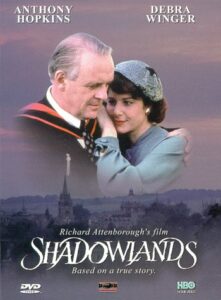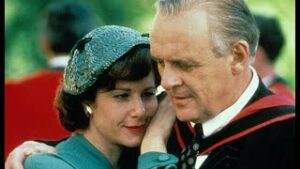“Shadowlands” – a Love Journey Redeemed by Suffering

Title: “Shadowlands”
Release Date: 1993
Director: Richard Attenborough
Cast: Anthony Hopkins, Debra Winger, Joseph Mazello, Edward Hardwicke, Roddy Maude-Roxby
“Shadowlands” is a beautiful, fact-based love story of British writer Clive Staples Lewis and American poet Joy Gresham. The movie was directed by the master of biographical cinema, Sir Richard Attenborough, who created a moving picture of an extremely subtle feeling, revealed only in dramatic circumstances. The difficult experience of his beloved’s terminal illness puts the author of the famous “The Chronicles of Narnia,” a thinker and philosopher, in the face of a great personal crisis that reevaluates the entire previous order of his world.
“Shadowlands” – C. S. Lewis meets Joy Gresham
The melodrama “Shadowlands” is an unusual story of a meeting between a famous English writer and Oxford lecturer and an American poet. One day C. S. Lewis (played by Anthony Hopkins) receives a letter from one of his faithful fans, a certain Joy Gresham (Debra Winger). The American woman writes that she is coming to Britain soon and asks the writer to meet her. Lewis, along with his brother, with whom he lives, invite the woman to meet him. The acquaintance, despite cultural differences, develops to such an extent that the professor decides to offer the poet and her son to spend Christmas with him. The woman confesses to him that the reason for her trip is the breakdown of her marriage and her husband’s abandonment of her for another. Soon Joy returns to America, and Lewis can’t forget her.
One day he unexpectedly meets the woman at a lecture, which renews their friendship. Joy asks Jack for an unusual favor: in order to get permission to stay in Britain, he must enter into a marriage of convenience. Lewis, very embarrassed, accedes to the woman’s request, but this changes nothing in the reserved and unclear relationship between them. Only when it turns out that Joy is suffering from bone cancer, the professor decides to overcome his inhibitions and fear of gossip from scholarly acquaintances and confesses his love to his friend. They soon have a Protestant wedding in the hospital, and Joy’s disease is in remission. The professor takes his spouse and them son Douglas to live with him. The two experience wonderful moments together. Happiness does not last long, however; another bout of the disease proves fatal. Devastated, Lewis experiences a spiritual crisis and doubt, but at the same time undertakes to raise his son Joy.

“Shadowlands” – Love as a confrontation of cultures and attitudes
“Shadowlands” is an extremely profound analysis of the nature of love, which can be a matter that is not at all easy and often forces a person to abandon or reevaluate previous views. Lewis and Joy, although both are people of letters, represent two radically different worlds. The most glaring sign of this difference is their nationality: she is an American with a direct and open manner, while he is the embodiment of a typical Briton, reserved and hidden behind a mask of good manners and conventions.
What is more, the protagonists also share an attitude toward creativity. Lewis is a philosopher and theorist, locked behind the walls of a centuries-old university representing prestige and a kind of protectionism. If he asks students a question, he knows the answer in advance, convinced of the validity of his own assessment. During a conversation he discusses courtly love with his students, setting its unfulfillment as the model of all affect. For he believes that “the greatest happiness lies not in the possession of something, but in the longing for something,” which makes the object of this affection eternal. Joy, on the other hand, is convinced that creativity should always flow from personal experience, forcing people to critically evaluate their judgments about the world. At first, therefore, it seems that these two different worlds are completely irreconcilable. Nevertheless, their amorous encounter results in a wonderful metamorphosis of the professor.
“Shadowlands” and the metamorphosis of C. S. Lewis
“Shadowlands” moves, first of all, with its extremely believable depiction of the transformation that only love is capable of making in a person. Anthony Hopkins insanely evocative impersonation of Professor Lewis, an old bachelor locked in his academic world, who only when he learns of Joy’s terminal illness, realizes that he may lose the most beautiful thing that has happened to him in life. Despite the fact that he is a man full of inhibitions, sensitive to the nudges from distinguished acquaintances who do not accept Joy’s differences, he does not just decide to confess his love for his beloved. These would be mere empty words.

Lewis offers her the most tender, empathetic care in physical suffering. Suddenly, his theoretical world collides with the real experience of corporeality, which is incompatible with idealistic notions. And it is in this matter that unexpectedly this hero passes the test. He is able to take care of his wife and her son, nurturing Joy in her disability and enjoying brief moments of happiness. The test, which many romantic lovers would not pass, the professor treats as a chance from fate to enjoy love. And he loves Joy with a love that is deep and faithful until her death.
The hitherto world of the protagonist of “Shadowlands” turns out to be a safe facade with which he tried to isolate himself from suffering. For the stigma on his life was the early death of his mother. Her loss was such a powerful blow to Lewis that, out of fear of similar pain, he decided to arrange his world without establishing deeper ties. Nevertheless, his love for Joy gives him courage, and despite his fear of suffering, the protagonist takes on the challenge of opening up to another person.
A walk through the “Shadowlands”
The central metaphor of the film is precisely the title “Shadowlands”, which appears in Attenborough’s work on several levels. First in the form of a picture from the children’s room of C. S. Lewis, which hangs in his professor’s office. As the man explains to Joy, it’s a real place, he himself, however, has never seen it, although he always dreamed of it and hoped it was just outside his home. The Golden Valley is thus synonymous with the safe, idealistic attitude of the dreamer, characteristic of the professor before he met the American poet.
The metaphor is also literary in nature, referring to one of the writer’s stories quoted in the film. “We live in the Shadowlands. The sun is always shining somewhere else, around the bend in the road, over the brow of the hill,” the professor says, naming his despondency into which he falls from longing for Joy. In this installment, the valley becomes a place of perpetual unfulfillment, searching, but also dissatisfaction with what one has. It’s an attitude characterized by an undervaluing of the present moment and living in a constant perspective of the future.

Finally, the valley makes itself present in the film in real form. Lewis and Joy go to this area on their one and final, most beautiful trip. It is a perfect combination of painterly, literary and real images. It is only then that the professor will say that now he is not waiting for what will be around the bend or over the hill. He is happy here and now, even though he is fully aware that the price of this happiness will be immense suffering.
Sun in “Shadowlands”
After Joy’s death, the protagonist experiences a terrible breakdown and a crisis of faith in divine providence. He, who gave whole lectures about the salutary meaning of suffering, when he experiences it for real, has no idea how to deal with it. It appears to him as senseless pain, having nothing to do with the divine plan. Theory loses in the clash with experience, and the anguish, instead of elevating, humiliates Lewis. The ultimate remedy turns out to be persistence in the prospect of the unexplained mystery of human powerlessness.
Lewis decides to take care of Douglas, as he promised his late wife. It is together with him that he experiences grief and admits for the first time that he does not know the answers to all questions. He, the old professor, becomes a student in the school of life, humbly accepting lessons from fate. The ending of Attenborough’s film offers the viewer solace. One can see here a compositional buckle constructed on the principle of contrast. While at the beginning we see Lewis walking in darkness, the finale depicts the hero wandering through a sunny valley. Moreover, he is accompanied by Douglas, a child who is a symbol of hope and the promise of the continuity of human destiny despite death and suffering. So even in “Shadowlands” the sun sometimes shines, and the whole secret is to know how to enjoy its warm fleeting rays.
